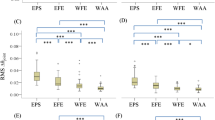Abstract
In a previous clinical investigation, jerky foot movements were observed in patients with akathisia. Tremographic techniques were empolyed in the present study to characterise this motor activity. Six psychiatric patients with signs and symptoms of akathisia, six control patients matched for antipsychotic drug dose, and five drug-free normal subjects, were selected and assessed for evidence of drug-induced movement disorders. The two patient groups proved to be closely matched on clinical and demographic variables. An accelerometer was used to record finger and toe tremor in all subjects according to a standard procedure. Analysis of the amplitude, frequency and wave-form data collected revealed that the akathisia patients were characterised by the presence of large amplitude, low frequency (less than 4 Hz), rhythmic foot movements. Changes in the severity of akathisia at follow-up were reflected in changes in the amplitude and frequency of this dyskinesia. Possible clinical and pathophysiological implications of the findings are presented.
Similar content being viewed by others
References
Ayd FJ (1961) A survey of drug-induced extrapyramidal reactions. JAMA 175:1054–1060
Barbiz W (1981) Further Fourier transforms. Practical Computing 112–113
Barnes TRE, Trauer T (1982) Reliability and validity of a tardive dyskinesia videotape rating technique. Br J Psychiatry 140:508–515
Barnes TRE, Braude WM (1983) Persistent akathisia associated with early tardive dyskinesia. Postgrad Med J (in press)
Braude WM, Barnes TRE, Gore SM (1983) Clinical characteristics of akathisia: a systematic investigation of acute psychiatric inpatient admissions. Br J Psychiatry 143:139–150
Calne DB, Lader MH (1968) Electromyographic studies of tremor using an averaging computer. Electroencephalogr Clin Neurophysiol 26:86–92
Carp JS, Anderson RJ (1982) Dopamine receptor-mediated depression of spinal monosynaptic transmission. Brain Res 242:247–254
Commissiong JW, Neff NH (1979) Current status of dopamine in the mammalian spinal cord. Biochem Pharmacol 28:1569–1573
Crane GE, Naranjo ER, Chase C (1971) Motor dissorders induced by neuroleptics — a proposed new classification. Arch Gen Psychiatry 23:179–184
Davis JM (1974) Dose equivalence of the antipsychotic drugs. J Psychiatr Res 11:65–69
Delay J, Deniker P (1968) Drug induced extrapyramidal syndromes. In: Vinken PJ, Bruyn GW (eds) Handbook of clinical neurology, vol 6. Diseases of the basal ganglia. North Holland, Amsterdam, pp 248–266
Dietrichson R, Engebretson O, Fonstelien E, Hovland J (1978) Quantification of tremor in man. In: Desmedt JE (ed) Physiological tremor, pathological tremors and clonus. Progress in clinical neurophysiology, vol 5. Karger, Basel, pp 90–94
Ellenor GL (1977) Reducing irradiational antipsychotic polypharmacy prescribing. Hosp Pharm 12:369–376
Findley LJ, Gresty MA (1981) Tremor. Br J Hosp Med 26:16–32
Halliday AM (1967) The clinical incidence of myoclonus. In: Williams D (ed) Modern trends in neurology, vol 4. Butterworths, London pp 69–105
Halliday AM (1975) The neurophysiology of myoclonic jerking — a reappraisal. In: Charlton MH (ed) Myoclonic seizures. Excerpta Medica International Conference Series. No. 307. Amsterdam, pp 1–29
Jenner P, Marsden CD (1982) Antiparkinsonian and antidyskinetic drugs. In: Tyrer PJ (ed) Drugs in psychiatric practice. Butterworths, London, pp 82–125
Mackay AVP (1982) Clinical controversies in tardive dyskinesia. In: Marsden CD, Fahn S (eds) Neurology 2, movement disorders. Butterworth Scientific, London, pp 249–262
Marsden CD, Meadows JC, Lange GW, Watson RS (1969) Variations in human physiological finger tremor, with particular reference to changes in age. Electroecephalogr Clin Neurophysiol 27:169–178
Marsden CD, Meadows JC, Lange GW (1970) Effect of speed of muscle contraction on physiological tremor in normal subjects and in patients with thyrotoxicosis and myxoedema. J Neurol Neurosurg Psychiatry 33:776–782
Marsden CD, Tarsy D, Baldessarini RJ (1975) Spontaneous and drug-induced movement disorders in psychotic patients. In: Benson DF, Blumer D (eds) Psychiatric aspects of neurological disease. Grune and Stratton, New York, pp 219–265
Marsden CD, Jenner P (1980) The pathophysiology of extrapyramidal side-effects of neuroleptic drugs. Psychol Med 10:55–72
Marsden CD, Hallett M, Fahn S (1982) The nosology and pathophysiology of myoclonus. In: Marsden CD, Fahn S (eds) Neurology 2, movement disorders. Butterworth Scientific, London, pp 196–248
Raskin DE (1972) Akathisia: a side-effect to be remembered. Am J Psychiatry 129:345–347
Research Group on Extrapyramidal Disorders of the World Federation of Neurology (1981) Classification of extrapyramidal disorders: proposal for an international classification and glossary of terms. J Neurol Sci 51:311–327
Rondot P, Jedynak CP, Ferrey G (1978) Pathological tremors: nosological correlates. In: Desmedt JE (ed) Physiological tremors, pathological tremors and clonus. Progress in clinical neurophysiology, vol 5. Karger, Basel, pp 95–113
Simpson GM, Angus JWS (1970) A rating scale for extrapyramidal side-effects. Acta Psychiatr Scand 212:11–19
Sovner R, DiMascio A (1978) Extrapyramidal syndromes and other neurological side-effects of psychotronic drugs. In: Lipton MA, DiMascio A, Killiam KF (eds) Psychopharmacology: A generation of progress. Raven Press, New York, pp 1021–1032
Van Putten T (1975) The many faces of akathisia. Comp Psychiatry 16:43–47
Van Putten T (1978) Drug refusal in schizophrenia: causes and prescribing hints. Hosp Comm Psychiatry 29:110–112
Van Woert MH, Hwang EC (1978) Biochemistry and pharmacology of myoclonus. In: Klawans HL (ed) Clinical neuropharmacology, vol 3. Raven Press, New York, pp 167–184
Wyatt RJ, Togrow JS (1976) A comparison of equivalent clinical potencies of neuroleptics as used to treat schizophrenia and affective disorders. J Psychiatr Res 13:91–98
Author information
Authors and Affiliations
Rights and permissions
About this article
Cite this article
Braude, W.M., Charles, I.P. & Barnes, T.R.E. Coarse, jerky foot tremor: Tremographic investigation of an objective sign of acute akathisia. Psychopharmacology 82, 95–101 (1983). https://doi.org/10.1007/BF00426389
Received:
Issue Date:
DOI: https://doi.org/10.1007/BF00426389




